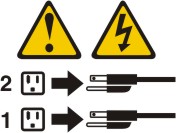Turning off the server
This topic provides information about turning off the server.
When you turn off the server and leave it connected to input power, the server can respond to requests to the service processor (the integrated management module), such as a remote request to turn on the server. While the server remains connected to input power, one or more fans might continue to run. To remove all power from the server, you must disconnect it from the power source.
Some operating systems require an orderly shutdown before you turn off the server. See your operating-system documentation for information about shutting down the operating system.
Statement 5
CAUTION
The power control button on the device does not turn off the electrical current supplied to the device. The device also might have more than one power cord. To remove all electrical current from the device, ensure that all power cords are disconnected from the power source.

The server can be turned off in any of the following ways:
- You can turn off the server from the operating system, if your operating system supports this feature. After an orderly shutdown of the operating system, the server will turn off automatically.
- You can press the power-on button to start an orderly shutdown of the operating system and turn off the server, if your operating system supports this feature.
- If the operating system stops functioning, you can press and hold the power-on button for more than 4 seconds to turn off the server.
- The integrated management module (IMM) can turn off the server as an automatic response to a critical system failure.
Give documentation feedback